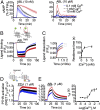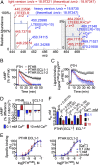Ca2+ allostery in PTH-receptor signaling
- PMID: 30718391
- PMCID: PMC6386702
- DOI: 10.1073/pnas.1814670116
Ca2+ allostery in PTH-receptor signaling
Abstract
The parathyroid hormone (PTH) and its related peptide (PTHrP) activate PTH receptor (PTHR) signaling, but only the PTH sustains GS-mediated adenosine 3',5'-cyclic monophosphate (cAMP) production after PTHR internalization into early endosomes. The mechanism of this unexpected behavior for a G-protein-coupled receptor is not fully understood. Here, we show that extracellular Ca2+ acts as a positive allosteric modulator of PTHR signaling that regulates sustained cAMP production. Equilibrium and kinetic studies of ligand-binding and receptor activation reveal that Ca2+ prolongs the residence time of ligands on the receptor, thus, increasing both the duration of the receptor activation and the cAMP signaling. We further find that Ca2+ allostery in the PTHR is strongly affected by the point mutation recently identified in the PTH (PTHR25C) as a new cause of hypocalcemia in humans. Using high-resolution and mass accuracy mass spectrometry approaches, we identified acidic clusters in the receptor's first extracellular loop as key determinants for Ca2+ allosterism and endosomal cAMP signaling. These findings coupled to defective Ca2+ allostery and cAMP signaling in the PTHR by hypocalcemia-causing PTHR25C suggest that Ca2+ allostery in PTHR signaling may be involved in primary signaling processes regulating calcium homeostasis.
Keywords: Ca2+ allosterism; GPCR signaling; PTH; PTH receptor; endosomal cAMP signaling.
Conflict of interest statement
The authors declare no conflict of interest.
Figures




References
Publication types
MeSH terms
Substances
Grants and funding
LinkOut - more resources
Full Text Sources
Other Literature Sources
Research Materials
Miscellaneous

